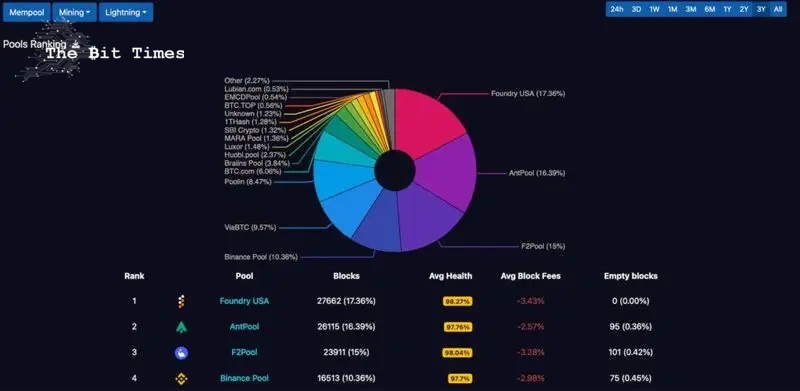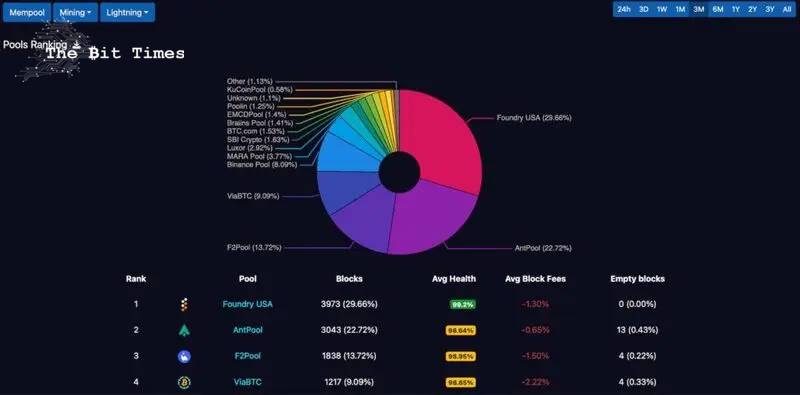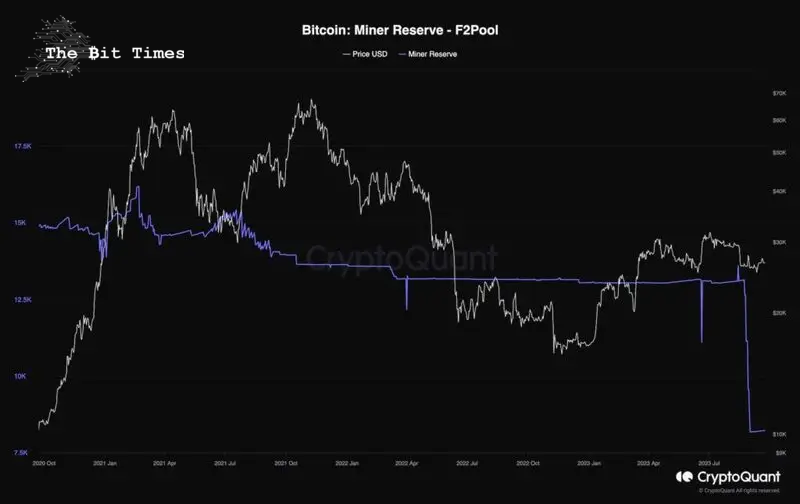
In the past years, it has been possible to observe a gradual, but constant trend of fewer Bitcoin (BTC) mining pools dominating the majority of the global network hashrate and block discovery. In this report, Finbold uses a data-based approach to analyze the decentralization state of the leading cryptocurrency network and explains why it is important.
ここ数年、グローバル ネットワークのハッシュレートとブロック検出の大部分を占めるビットコイン (BTC) マイニング プールが徐々に減少し、一定の傾向が見られるようになりました。このレポートでは、フィンボルド氏がデータベースのアプローチを使用して主要な暗号通貨ネットワークの分散化状態を分析し、それがなぜ重要なのかを説明しています。
Going from an unknown number of Bitcoin miners having the majority of its hashrate since the first block was mined by Satoshi Nakamoto, to four mining pools having mined over 59% of all blocks in the last three years, and only two of these institutions dominating over 52% of the new BTC distribution in the last three months.
最初のブロックがサトシ・ナカモトによってマイニングされて以来、未知の数のビットコインマイナーがそのハッシュレートの大部分を所有していましたが、過去 3 年間で 4 つのマイニングプールが全ブロックの 59% 以上をマイニングし、そのうちの 2 つの機関のみが支配的になってきました。過去 3 か月間の新規 BTC 配布の 52%。
Bitcoin mining decentralization state
ビットコインマイニングの分散化状態
This data was gathered from mempool.space pools ranking, which analyses the hashrate dominance by looking at who was responsible for each block ever added to the Bitcoin blockchain in each timeframe. Consequently receiving the reward in BTC through the creation of new coins — until the maximum limit of 21 million is achieved in the next 120 years (approximately).
このデータは、mempool.space のプール ランキングから収集されたもので、各時間枠でビットコイン ブロックチェーンに追加された各ブロックの責任者を調べることによってハッシュレートの優位性を分析します。その結果、(およそ)次の 120 年間で上限の 2,100 万に達するまで、新しいコインの作成を通じて報酬を BTC で受け取ることになります。
All-time Bitcoin blocks discovery
オールタイムビットコインは発見をブロックします
At the time of publication, a total of 808987 Bitcoin blocks were mined and added to the blockchain. Resulting in a total of 19,493,656 BTC being distributed to each of the lucky miners (or mining pools) that discovered each of these blocks by providing Proof of Work (PoW) through hash calculations.
出版時点では、合計 808,987 ビットコイン ブロックがマイニングされ、ブロックチェーンに追加されました。その結果、ハッシュ計算を通じて Proof of Work (PoW) を提供することによって、これらのブロックのそれぞれを発見した幸運なマイナー (またはマイニング プール) のそれぞれに合計 19,493,656 BTC が分配されることになります。

暗号通貨
This model identifies next Bitcoin ATH and price
このモデルは次のビットコイン ATH と価格を特定します

暗号通貨
Did Venezuela subsidize Bitcoin Miners run by criminals inside prison?
ベネズエラは刑務所内で犯罪者が運営するビットコインマイナーに補助金を出したのか?

暗号通貨
Coffee time: Bitcoin analyst sees bullish cup and handle pattern
コーヒータイム:ビットコインアナリストは強気のカップアンドハンドルパターンをみる

暗号通貨
Bitcoin price correction: Indicators hint at 'buy the dip' bonanza
ビットコイン価格修正:指標は「押し目買い」の大当たりを示唆

暗号通貨
Musk’s DOGE dream: What if Tesla bought Dogecoin instead of Bitcoin?
マスク氏の DOGE の夢: テスラがビットコインの代わりにドージコインを購入したらどうなるでしょうか?
Interestingly, from these 808,987 blocks, 220,716 (27.29%) were mined by unknown entities — mostly in the early days of the network, probably by individual and domestic miners, or yet unidentified mining companies.
興味深いことに、これらの 808,987 ブロックのうち、220,716 (27.29%) が未知の組織によってマイニングされました。そのほとんどはネットワークの初期に、おそらく個人および国内のマイナー、または未確認のマイニング会社によって行われました。

3-year Bitcoin global hashrate decentralization
3 年間のビットコインのグローバル ハッシュレート分散化
However, the scenario starts to change as Bitcoin becomes more recognized and the industry matures. Bitcoin miners — looking for more predictability in a highly competitive ‘winner takes all’ activity — started to unite forces (or hashrates) in mining pools. Effectively increasing their chance to mine a valid block and share the block reward.
しかし、ビットコインの認知度が高まり、業界が成熟するにつれて、シナリオは変わり始めます。ビットコインマイナーは、非常に競争の激しい「勝者総取り」アクティビティでより予測可能性を求めて、マイニングプールで力(またはハッシュレート)を団結させ始めました。有効なブロックをマイニングし、ブロック報酬を共有するチャンスを効果的に高めます。
This drastically changed the network’s decentralization state as seen in the last 3 years’ results, with only four pools providing over 59% of the global hashrate:
過去 3 年間の結果に見られるように、これによりネットワークの分散化状態が劇的に変化し、グローバル ハッシュレートの 59% 以上を提供するプールは 4 つだけになりました。
- Foundry USA (17.36%)
- AntPool (16.39%)
- F2Pool (15%)
- Binance Pool (10.36%)
ファウンドリーUSA (17.36%)
アントプール (16.39%)
F2プール (15%)
バイナンスプール (10.36%)

3-month BTC new supply distribution
3ヶ月BTC新規供給量分布
Notably, the trend continues as time goes by. Bitcoin domestic mining is not feasible anymore, smaller companies are not able to survive while operating underwater, and the remaining survivors get more concentrated in fewer pools for even higher revenue predictability.
注目すべきことに、この傾向は時間が経っても継続します。ビットコインの国内マイニングはもはや実行不可能であり、小規模企業は水中で事業を続けながら生き残ることができず、生き残った企業はさらに高い収益の予測可能性を求めてより少ないプールに集中することになります。
In the last three months, only two mining pools received more than half of all the Bitcoin supply distribution which is set as 6.25 BTC per mined block — that happens on average every 10 minutes, for around 900 BTC/day.
過去 3 か月間で、採掘されたブロックあたり 6.25 BTC として設定されているビットコイン供給量全体の半分以上を受け取ったマイニング プールは 2 つだけでした。これは平均して 10 分ごとに発生し、1 日あたり約 900 BTC になります。
Foundry USA received around 24,831.25 BTC for mining 3,973 blocks (29.66%), while AntPool received around 19,018.75 BTC for mining 3,043 blocks (22.72%). This results in a total of 43,850 BTC accrued by these pools in the last 90 days, equal to $1.16 billion considering Bitcoin is priced at $26.500 by press time.
Foundry USA は 3,973 ブロック (29.66%) のマイニングで約 24,831.25 BTC を受け取りましたが、AntPool は 3,043 ブロック (22.72%) のマイニングで約 19,018.75 BTC を受け取りました。これにより、過去 90 日間にこれらのプールで合計 43,850 BTC が発生しました。これは、記事執筆時点でのビットコインの価格が 26,500 ドルであることを考慮すると、11 億 6,000 万ドルに相当します。

Why is Bitcoin PoW decentralization important?
Bitcoin PoW の分散化が重要なのはなぜですか?
Proof of Work decentralization is important from both a financial and technical security point of view.
Proof of Work の分散化は、財務的および技術的なセキュリティの観点から重要です。
A more decentralized Bitcoin distribution helps avoid market price manipulation, which can happen when fewer entities hold a larger share of the supply or exchanged volume. It also diminishes the effect of a single entity sell-off, as seen recently by F2Pool — currently the third largest mining pool.
ビットコインの分散化が進むと、市場価格操作を回避できます。これは、少数の主体が供給量や交換量の大きなシェアを保持する場合に発生する可能性があります。また、現在 3 番目に大きいマイニング プールである F2Pool で最近見られたように、単一事業体の売却の影響も軽減されます。

Moreover, a more decentralized network also means that it is harder for a malicious entity to take over the consensus, which could, theoretically, allow for double spending through a 51% attack — when someone spends the same coin twice, like using a fake US dollar.
さらに、ネットワークの分散化が進むということは、悪意のある組織がコンセンサスを乗っ取ることが難しくなることも意味しており、理論的には、偽の米国通貨を使用するなど、誰かが同じコインを 2 回使う場合、51% 攻撃による二重支出が可能になる可能性があります。ドル。
Although Bitcoin mining pools function with the collaborative work of multiple mining companies or individual miners, these contributors are only providing work through hash calculations. It is the pool coordinator who adds transactions to the block template, signs and broadcasts the block to the network, and receives the block reward to be distributed later among the miners.
ビットコイン マイニング プールは複数のマイニング会社または個々のマイナーの共同作業によって機能しますが、これらの貢献者はハッシュ計算を通じてのみ作業を提供しています。ブロック テンプレートにトランザクションを追加し、ブロックに署名してネットワークにブロードキャストし、後でマイナー間で分配されるブロック報酬を受け取るのはプール コーディネーターです。
All things considered, the more decentralized cryptocurrencies’ networks are, the more secure and valuable they can become long-term.
すべてを考慮すると、暗号通貨のネットワークが分散化すればするほど、長期的にはより安全で価値のあるものになる可能性があります。
出典: https://thebittimes.com/this-is-how-centralized-bitcoin-mining-has-become-over-the-years-report-tbt63789.html


 Crypto News Land
Crypto News Land CoinPedia News
CoinPedia News DogeHome
DogeHome CoinoMedia
CoinoMedia Optimisus
Optimisus Coin Edition
Coin Edition BitcoinWorld
BitcoinWorld Optimisus
Optimisus






















